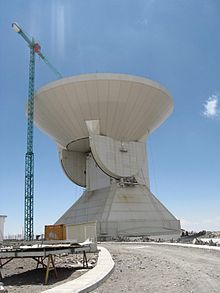
Large Millimeter Telescope

The Large Millimeter Telescope (LMT) (Spanish: Gran Telescopio Milimétrico, or GTM) -officially Large Milimeter Telescope Alfonso Serrano (Spanish: Gran Telescopio Milimétrico Alfonso Serrano)- is the world's largest single-aperture telescope in its frequency range, built for observing radio waves in the wave lengths from approximately 0.85 to 4 mm. It has an active surface with a diameter of 50 metres (160 ft) and 1,960 square metres (21,100 sq ft) of collecting area. It is located at an altitude of 4850 meters on top of the Sierra Negra, the fifth highest peak in Mexico and an extinct volcanic companion to Mexico's highest mountain, the Pico de Orizaba, inside the National Park Pico de Orizaba in the state of Puebla. It is a binational Mexican (80%) – American (20%) joint project of the Instituto Nacional de Astrofísica, Óptica y Electrónica (INAOE) and the University of Massachusetts Amherst. Millimetre wavelength observations using the LMT will give astronomers a view of regions which are obscured by dust in the interstellar medium, thus increasing our knowledge about star formation. The telescope is also particularly fitted for observing solar system planetesimals and planets and extra-solar protoplanetary disks which are relatively cold and emit most of their radiation at millimetre wavelengths. The mission of the LMT is: 1) pursuing pioneering research, 2) train the future generations of scientists and engineers and 3) develop new technology for the benefit of society. The LMT mainly studies thermally cold objects, most of them associated to large amounts of cosmic dust and/or molecular gas. Among the objects of interest are: comets, planets, protoplanetary discs, evolved stars, star-forming regions and galaxies, molecular clouds, active galactic nuclei (AGNs), high-redshift galaxies, clusters of galaxies and the cosmic microwave background. The LMT is a bent Cassegrain optical system with a 50m-diameter reflecting primary surface (M1) formed by 180 segments, these are distributed in five concentric rings. The number of segments in the rings, from the center of the dish to the outside are: 12, 24 and 48 in the three outermost rings. Each segment is connected to the structure of the telescope through four actuators, allowing to have an active reflecting primary surface. As well, each segment is formed by eight precision electro-formed nickel sub-panels. The reflecting secondary surface (M2) has a 2.6m diameter, also built by nine electro-formed nickel sub-panels, and is attached to the telescope with an active hexapod that allows precise focus, lateral offsets and tilts. The hexapod is attached to the telescope through a metal tetrapod. Finally, the reflecting tertiary surface (M3) is almost flat, elliptical with a 1.6m major axis and delivers the light beam to the receivers. INAOE and UMass-Amherst signed the agreement to develop the Large Millimeter Telescope project on 17 November 1994, but construction of the telescope did not begin until 1998. The first observations were taken on June 2011 at 1.1 and 3 mm using the AzTEC camera and Redshift Search Receiver (RSR), respectively. On May 2013, the Early Science phase began, producing over a dozen scientific articles. The official name of the LMT was changed to 'Large Millimeter Telescope Alfonso Serrano' on 22 October 2012 in order to honor the initiator of the project, Alfonso Serrano Pérez-Grovas.
